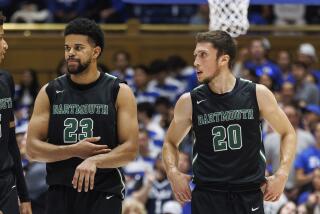Cassidy Criticizes NCAA Limits on Off-Season Drills
- Share via
They are, to a coach or student of the game, the three Rs of basketball: rebounding, rapport and, of course, reading defenses.
So how is it, Pete Cassidy would like to know, that he, as men’s basketball coach at Cal State Northridge, is restricted from teaching his profession’s core curriculum but other educators are not?
The National Collegiate Athletic Assn., to protect athletes from overzealous coaches, this year instituted limitations on the hours athletes are allowed to practice.
In the case of basketball, coaches can demand only eight hours a week during the off-season; 20 during the season, including games.
All of which is fine and dandy with Cassidy. He says curbing time obligations is “a good judgment call.”
Just don’t anybody try to tell him how to utilize those ever-so-valuable moments.
Unfortunately for Cassidy, the NCAA did.
The eight hours during the off-season are designated only for conditioning exercises. The use of basketballs is strictly prohibited. Also, the off-season was extended from Oct. 15 to Nov. 1, only a month before the traditional start of the regular season.
For Cassidy, a double-whammy.
Northridge opens the regular season Tuesday night at 7:30 on the road against Fresno State with a roster that has been crippled by injury, tragedy, academic ineligibility and defection.
Geoff Gorham, a 6-foot-7 swingman, suffered a broken leg and decided to renounce his scholarship. John Flowers, a 6-5 swingman who was the Matadors’ top recruit, lost both legs in a car accident.
Victor Camper, a 6-8 junior who was expected to start at forward or center, will not play until at least mid-December because he needs to pass a junior college math course. Percy Fisher, a 6-7 three-year letterman, quit the team.
Northridge has six front-line players left: Jason Stewart, a 6-foot-9 sophomore, and Robert Biggs, a 6-5 senior, are walk-ons with no collegiate experience. Josh Willis is a freshman who was recruited after the Matadors knew they were losing Gorham. Chris Yard, a starter at power forward, is a transfer from Lassen College.
The only front-line players with Division I experience are center Peter Micelli and reserve swingman Anthony Moten. Together, they have played 135 minutes. Micelli accounts for all but 10 of those minutes. He redshirted last season after averaging 1.8 points and 1.5 rebounds as a freshman in 1990-91.
If ever Cassidy and his coaching staff needed time to teach, this season was it. His team’s misfortune has frustrated him. The NCAA has rankled him.
“Sometimes (NCAA legislators) look at us as little more than recruiters, as car salesmen,” Cassidy said. “I think most coaches consider themselves educators, teachers, first. We would like to be treated as such.”
Cassidy, in his 22nd year as Northridge coach, concedes there are coaches who, given an option, would dominate the personal lives of their players.
For that reason, he says, time constraints make sense. His complaint is that coaches are not allowed to make good use of the time.
“It doesn’t take a Phi Betta Kappa to take a kid out on the lawn and run him,” Cassidy said. “He gets cardiovascular conditioning, but he doesn’t learn a damn thing from it.
“What is illogical is that if they gave us eight hours a week in the off-season to work with the kids and we could use the ball, teach them some skills, we could get them in shape through basketball.”
Cassidy questions why universities spend time and money scrutinizing players during the recruiting process and then are restricted from instructing them.
He compares the system to a history major being told to study on his own for two months and then given a month to prepare for a series of finals.
“And the thing is,” Cassidy said. “You can’t cram. You can cram easier for a history exam than you can for the development of physical skills and habits. We all know (cramming) is not the best form of learning, yet as coaches we are put in a position where we have to ask our players to do it.”
At Northridge, the gym is open each afternoon from the start of the semester in August until basketball practice starts. Cassidy wonders if NCAA legislators really believe players spend their spare time in the library.
“I’ll tell you where they are,” Cassidy said. “They’re down there in the gym playing basketball.”
Indeed, the NCAA rule doesn’t discourage athletes from playing, only their coaches from watching them. Instead of a structured practice, the players participate in pickup games.
Cassidy sees them acquiring bad habits at a time when they could be learning valuable lessons from a qualified coach. “I’ve spent 30 years of my life preparing myself to teach,” Cassidy said. “Why not let me do it?
“To eliminate us from even observing them, where we don’t have any control at all, is totally wrong. The mission of a university is to educate.”
Cassidy has heard some coaches might be making a detour around the rule by designating “practice captains”--players who supervise their teammates in unofficial workouts.
He considers such arrangements “playing in a gray area.”
“It becomes a question of how you can manipulate the rule,” Cassidy said. “It creates situations where people do things illegal. It compromises kids. It compromises coaches. And why?
“Because it’s a bad rule.”
One which, for Northridge, couldn’t have come at a worse time.
* CSUN WOMEN’S PREVIEW
After a good recruiting year, Matador women’s Coach Kim Chandler is confident her team can bounce back from last season’s 2-24 debacle. C21
More to Read
Go beyond the scoreboard
Get the latest on L.A.'s teams in the daily Sports Report newsletter.
You may occasionally receive promotional content from the Los Angeles Times.











